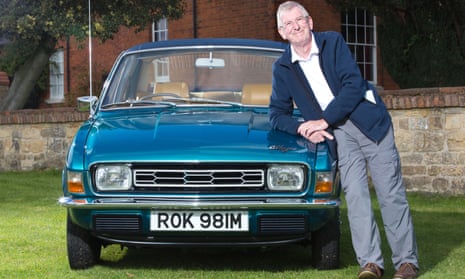
Harris Mann obituary
Harris Mann, who has died aged 85, came to prominence with his 1973 design for the Austin Allegro, perhaps the most lampooned British car of recent times. In the four decades since its demise, the unfairly derided Allegro has become a lazy shorthand for everything that was wrong with British Leyland – and even Britain itself – in the 70s, becoming the comic turn of the classic car world.
In truth, the Austin Allegro was much more warmly received than its latter-day critics would have you believe. It sold respectably for 10 years in a market that was much harsher than the one its million-plus selling predecessor had faced. The much-loved Austin 1100 – famously thrashed by John Cleese in Fawlty Towers – was a tough act to follow: when it became common knowledge that early Allegros leaked and would even pop their rear screens out if jacked up in the wrong place, some suggested that Leyland had managed the rare trick of building a new model that was worse than the old one. In fact, many Allegro sales were lost to simple shortages at a time when the Longbridge factory on the outskirts of Birmingham was embroiled in strike action.
Mann was the first to admit that dated manufacturing practices and build quality did not help the reputations of any of the cars he designed for BL in the 1970s. He also pointed out that many other carmakers – foreign and domestic – suffered from the same problems but were more adept at keeping quiet about it.
As the UK prepared to enter the EEC in 1973, much was riding on the success of the in-house styled Allegro. With his long hair and flamboyant suits, the talented and self-effacing Mann was groomed as the “face” of the new car: the British answer to the latest crop of young Italian designers such as Giorgetto Giugiaro, who shared Mann’s taste for the exotic wedge shapes that would be the defining trend of the decade.
Giugiaro’s much-praised 1971 Alfa Romeo Alfasud had been an influence on BL’s “song for Europe” Allegro, but it was Mann’s radical Triumph TR7 and Austin Princess of 1975 that would give the wedge-shaped automobile mass market appeal.
None of the Allegro’s ills could be laid at the door of Mann. His renderings for the Allegro show a sleek design that is hard to reconcile with the barrel-sided reality of the vehicle revealed to the public.
He was not responsible for the infamous Quartic “square” steering wheel fitted to early models – a much-derided attempt to provide poor-man’s power steering which, had it appeared on a Citroën, would doubtless have been lauded as yet another example of Gallic brilliance.
The pig-nosed Vanden Plas luxury version of the Allegro was also not Mann’s doing. That car had such a firm following among elderly motorists that one reviewer suggested it should come as standard with a bifocal windscreen.
Good natured, unassuming and greatly loved by the car clubs that honoured his designs, Mann spent much of his retirement explaining to journalists that the proportions he envisaged on paper for the Allegro were ruined by the Leyland engineers who, for cost reasons, needed to make use of bulky off-the-shelf components designed for other BL cars.
Mann was born in north London. His mother worked at the War Office as a statistician, and his father owned a plumbing firm. After attending Ebury Technical College in Westminster and a short stint as a body engineer with the coachmakers Duple, Mann emigrated to New York in the late 50s to work at the Raymond Loewy industrial design consultancy.
There, Mann had little contact with the great French design guru and spent six months designing tread patterns and side walls for tyres.
On his return to the UK, his career suffered a blip due to a lengthy period of national service, but in 1962 Mann joined Ford of Britain as a feasibility engineer, and within a few months he had charmed his way into the styling studios. He stayed for five years, working on the Mk2 Cortina, the original Escort and the Capri.
The move to British Leyland – then still called BMC, the British Motor Corporation – came in 1967, when he was wooed over to Cowley, Oxfordshire, by his former Ford boss Roy Haynes to help create what would become the Morris Marina. Shocked by the fusty, prewar atmosphere at the site, Mann later recalled being treated with disdain by Alec Issigonis, the creator of the Mini, because he did not have an engineering degree.
When Haynes resigned in 1970, more responsibility fell on Mann. After the Allegro, as head of styling, he was given a freer hand to develop his famous wedge shapes of the mid-70s.
The 18-22 Series (later renamed Princess) was a bold family saloon whose only major failing was its lack of a fifth (hatchback) door at a time when the foreign competition were adopting this feature in ever greater numbers. His even more radical TR7, favoured over Italian proposals, shocked traditional Triumph sports car buyers, yet went on to become the bestselling TR of all.
Mann left BL in 1983 for BMW’s motorcycle division in Germany, having worked on the Austin Metro and Maestro. He returned to the UK and the Midlands in the 2000s to work alongside Peter Stevens on MG and Rover projects while also lecturing at Coventry University.
In retirement Mann could often be found at gatherings of 70s and 80s Leyland cars, talking to enthusiasts and sometimes judging fastidiously preserved examples of the once vilified but now much-loved vehicles he gave life to.
In 1969 Mann married Anne, and they settled in Worcester. She predeceased him. Their three children, Hanna, Nathan and Laura, survive him.